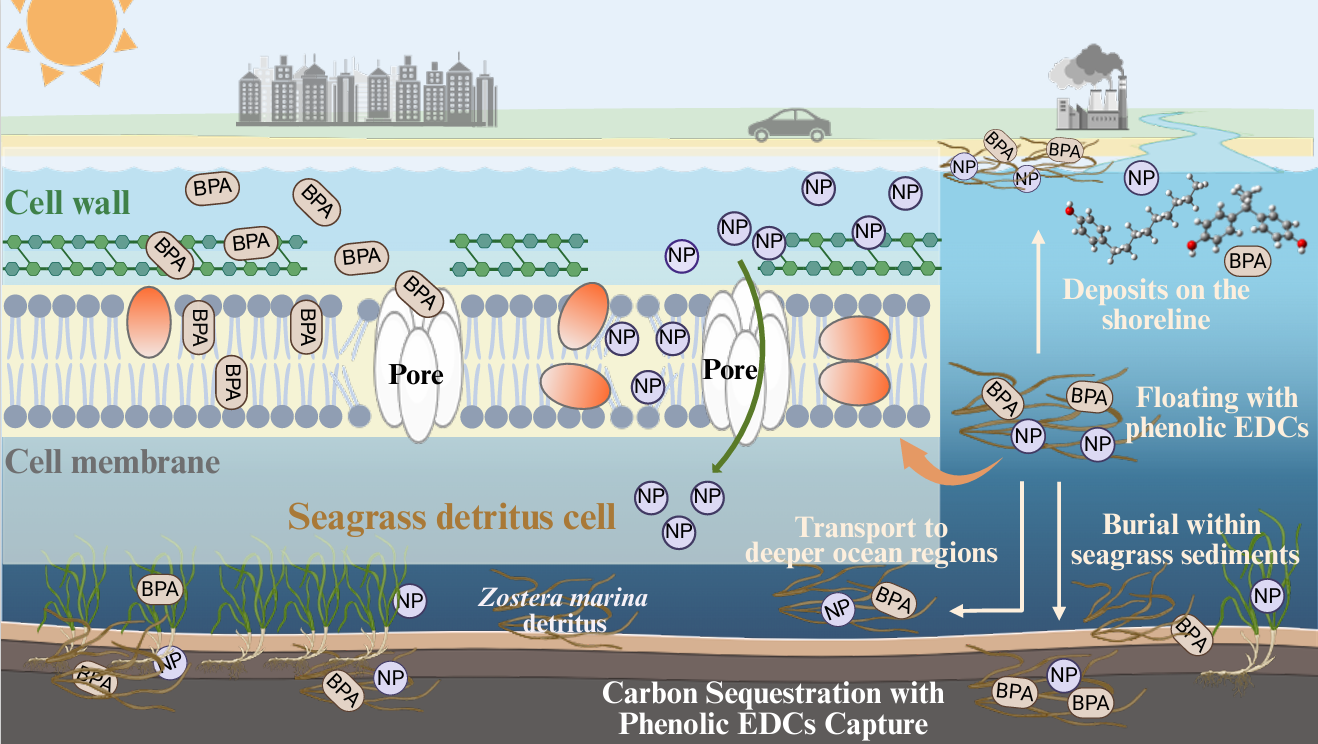In recent years, emerging pollutants, particularly endocrine-disrupting chemicals (EDCs) such as nonylphenol (NP) and bisphenol A (BPA) in marine environments, have drawn widespread attention. Their strong estrogen receptor-binding abilities, posing a significant threat to both marine ecosystems and human health. Seagrass meadows, as a vital component of marine ecosystems, are widely recognized for their roles in carbon sequestration, water quality purification, and biodiversity maintenance. However, the influence of their detritus decomposition process on marine carbon cycling and pollutant migration has not been systematically evaluated.
Addressing this scientific gap, the research team led by Professor Jian Lu from the Yantai Institute of Coastal Zone Research, Chinese Academy of Sciences, systematically evaluated the potential and mechanisms of seagrass detritus in simultaneously capturing EDCs and enhancing carbon sequestration. The study focused on detritus from Zostera marina L., and the experimental results showed that it had a capture efficiency of over 90% for typical EDCs. Under different environmental conditions such as pure seawater, non-buried, and buried systems, the re-release rate of EDCs was below 20%. Compared to the control group, the total organic carbon (TOC) stocks in the EDC-treated groups increased dramatically by 21.5%–28.8%. Under burial scenarios, seagrass detritus further enhanced its long-term carbon storage capacity by inhibiting its decomposition process. This discovery revealed the dual ecological value of seagrass detritus in both pollution reduction and carbon sequestration.
On a mechanistic level, the research team using laser scanning confocal microscopy (LSCM) and density functional theory (DFT) calculations, found that NP mainly binds to the lipid-rich areas of detritus through hydrophobic interactions, while BPA primarily relies on electrostatic interactions with the polysaccharide structure for efficient adsorption. The physicochemical properties of the pollutants, such as polarity and molecular structure, as well as environmental factors (e.g., pH and salinity), dramatically affect the capture efficiency. This result deepens the understanding of the ecosystem services provided by seagrass and offers a new perspective for analyzing pollutant migration and transformation in marine environments.
From an application perspective, seagrass detritus with its high-efficiency, low-cost pollutant removal ability and significant carbon sequestration potential, provides an innovative and sustainable strategy for marine ecological restoration. It can serve as a natural ecological barrier, establishing pollutant interception buffer zones in coastal pollution hotspots, effectively preventing pollutants from spreading to open marine areas while achieving the dual goals of improving coastal water quality and enhancing blue carbon storage. This research also provides strong scientific support for the “blue carbon” strategy in the context of global climate change. Protecting and restoring seagrass meadows not only helps maintain biodiversity but also significantly enhances the overall benefits of marine ecosystems by strengthening the pollutant capture and carbon storage functions of seagrass detritus.
The research was conducted by Assistant Researcher Cui Zhang from the Yantai Institute of Coastal Zone Research, Chinese Academy of Sciences, with Professor Jian Lu as the corresponding author. The research was funded by the National Natural Science Foundation of China, the Shandong Provincial Natural Science Foundation, the Taishan Scholars Program, and the Ocean Negative Carbon Emissions (ONCE) Program. The results were published in the Environmental Science & Technology journal, providing important innovative theoretical support for marine pollution control and carbon cycling research.

Illustration of the dual mechanism of seagrass detritus in capturing new pollutants and enhancing carbon sequestration
Reference
Zhang Cui, Lu Jian*, Wu Jun, Xiong Bitao. Neglected Biogeochemical Process for Ocean Health: Seagrass Detritus Simultaneously Enhances Phenolic Endocrine-Disrupting Chemical Capture and Organic Carbon Sequestration. Environmental Science & Technology, 2025, 59(21): 10533-10544. https://pubs.acs.org/doi/10.1021/acs.est.5c03543